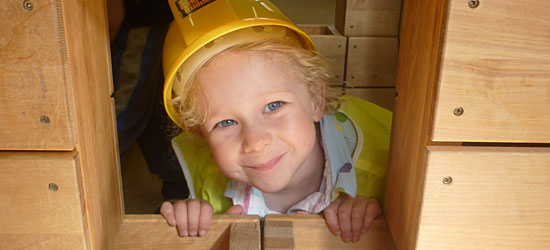Happy spaces
| June 2012In the context of designing childcare settings, the term environment usually refers to the classroom, but it has a three-fold definition. Besides the physical space and how it looks, feels, smells, two other elements included in the word environment are equally important. The people that inhabit the space are part of the environment: their behaviour, their likes and dislikes, their ages and how they feel; the time they spend in the space is an essential component as well. By taking each of these into consideration, simple, practical steps can be taken to create an optimal learning environment for children by providing emotional stability and work efficiency.
Physical space
The most obvious aspects of environment are the elements that characterise the room itself: shelves, tables and chairs, plants, windows, wall colour. Within the room each corner or activity area should be a mini environment indicating to children what is expected of them in each area. In her book Child Care Design Guide, Anita Olds identifies five attributes of an activity area: Location, Play and Sitting Surfaces, Storage and Display, Mood, and Boundaries. I want to discuss these five attributes in relation to space, people, and time in the environment and finally offer some guidelines, a simple seven-step method, to designing an effective environment for young children.
Location
Location is important to the individual functioning of each activity area as well as the overall harmony and balance in the room. Locating related activities near each other and convenient to the contours and restrictions of the room helps us to best use the space. For this reason we do not put the cosy corner near the sink and the block corner just inside the front door. Role play goes well with blocks, and sand and water adds a wonderful dimension to the science or art areas.
Play and sitting surfaces
Children love to sit on the floor; there they have more control of their bodies and can adjust their height according to their activity. We have to keep this in mind when setting up activity areas. Sometimes a table can be limiting. But what about a table that can be instantly adjusted to standing height, so a child does not have to bother with the chair? Or what about a low platform 20–30 cm high at which a child can still kneel, but not run the risk of bumping his construction by mistake?
Anita Olds recommends the standard table height to be 20 cm from the seat of a chair. It is necessary to take time to consider these small details, because children will not be able to talk about their discomfort, but it will reflect in their behaviour.
People
We know that an environment has a substantial impact on our behaviour. A good way to create a functional environment for children and teachers is to engage in a concurrent planning process. This can be achieved in many different ways, through meetings, questionnaires, contests, but the ultimate object is to allow children, teachers, parents, and janitors to voice their needs and make suggestions for the final layout of the space they will be using.
Recent studies have shown the increase of stress in our daily lives has a negative effect on everything from how we relate to each other to how we grow. Lack of space, too much stimulation and the absence of soft spaces and open materials lead to a stressful environment for both children and adults. So reducing stress by providing calm, emotionally appealing spaces for teachers and children will go a long way in encouraging the learning process. Rather than frantic teachers trying to control a chaotic classroom, we must aim to equip teachers with a supportive environment that allows them to facilitate learning, rather than being purveyors of materials and services.
Mood
Everyone who works with children agrees that one of the experiences our children miss most is intimate contact with the outdoors. No child can get enough of its softness, greenness, changing light, varying temperatures and fresh air, but what we can do is maximise the use of natural light from the classroom windows. The changing of seasons, times of day and weather cast different lights and a patterns into a room and create a predictable and calming effect on children and adults. Natural light has the greatest influence on the creative process and literacy functions. In arranging a room, try to place the reading/writing and art areas nearest to the windows.
Clutter can make or break the mood of an environment. Jumbled toys, naked dolls, missing puzzle pieces and unclaimed clothing will make a room chaotic and uninviting. Two shelves in each activity area with a limited variety of toys in organised containers, rotated frequently by staff is much more likely to encourage an industrious and harmonious setting.
Storage and display space
Storage and display are among the essential attributes of activity areas. These can promote independence and encourage the educational process by prolonging concentration, inhibiting distraction and encouraging child-initiated investigation. If materials are well organised and easily accessible, fewer pieces will be lost, there is less chance of spilling, and the frustrations of waiting are minimised. Place shelves at right angles to the walls, so that valuable wall space can be used for display. The backs of some shelves also lend themselves well to exhibiting children’s artwork.
Time
A not so obvious component of the environment, but one impossible to ignore in our fast-paced way of life, is time. Over 12 million children in the US alone spend time in child care. If a child spends eleven hours a day, five days per week, fifty weeks a year in the classroom, that comes to 13,000 hours – equivalent to all the time you spent in elementary and high school combined. And remember, the first five years are the most formative in a person’s entire life. Common sense tells us this is not natural and in many cases, not fair. Even in the best programme, what a child truly needs is a secure home and the great outdoors. Last year, "Psychology Today" published a study that about one-quarter of the children who spend more than 45 hours a week in daycare centres develop serious behavioural problems in later years, including aggression and hyperactivity. Interestingly, this seemed to have little bearing on the quality of the programme.
Pathways and boundaries
Pathways and Boundaries affect the way occupants of a room move through it and are able to use their time. Achieving efficiency in an environment is an important goal, and steps should be taken to define the needs of the people who will be using the space, their frustrations, their behaviour patterns and cultural differences. For example, a long hallway says to a child, “Run, child, run!” This same concept translates into classroom arrangement; the layout should be a maze, a meandering path that leads a child deliberately from one activity to another.
Pathways
Keeping these pathways at least 3 feet wide maintains easy access through the room for both teachers and children. It is also the typical egress requirement for fire codes as well as accessibility guidelines for people with disabilities.
Boundaries
There are many different ways of creating boundaries in a child care setting. From a solid half-wall (which, although it’s a darling of architects, will greatly hinder the flexibility of your space), to a shelf, a carpet line or even a strip of masking tape on the floor, boundaries indicate to a child where to go and when to stop. Shelves or panels should be used as solid boundaries and to protect floor-based activities and quiet occupations that require concentration, like maths or reading. Active or messy activity areas can have more fluid boundaries: an arch for a dramatic play centre, a change in wall colour, an area rug or even a piece of fabric hung from the ceiling can be enough of an hint, “Now you are leaving one activity area and entering a new one.”
Conclusion and outlook
Obviously, this is only a beginning. No amount of advice will work for everyone’s classroom and creating the ideal is difficult, if not impossible. But it is important that as child care providers we continue to assess and make improvements in the environment. By sharing ideas and being aware of behavioural patterns, and then taking action, we can try to give children the childhood they deserve. As my great-grandmother said in her 90th year of wisdom: If you make children happy now, you will make them happy 20 years hence by the memory.








